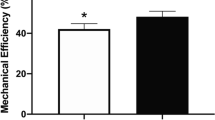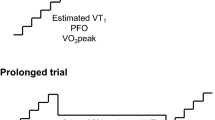Abstract
Purpose
The biomechanical differences between cyclists with a high compared with a low blood lactate threshold (HLT; 80% VO2max vs LLT, 70% VO2max) have yet to be completely described. We hypothesize that HLT cyclists reduce the stress placed on the knee extensor muscles by increasing the relative contribution from the hip joint during high-intensity cycling.
Method
Sixteen well-trained endurance athletes, with equally high VO2max while cycling and running completed submaximal tests during incremental exercise to identify lactate threshold (\({\text{LT}}_{{V{\text{O}}_{2} }}\)) while running and cycling. Subjects were separated into two groups based on % VO2max at LT during cycling (high; HLT: 80.2 ± 2.1% VO2max; n = 8) and (LLT: 70.3 ± 2.9% VO2max; n = 8; p < 0.01). Absolute and relative joint specific powers were calculated from kinematic and pedal forces using inverse dynamics while cycling at intensities ranging from 60–90% VO2max for between group comparisons.
Result
There was no difference between HLT and LLT in \({\text{LT}}_{{V{\text{O}}_{2} }}\) (p > 0.05) while running. While cycling in LLT, knee joint absolute power increased with work rate (p < 0.05); however, in HLT no changes in knee joint absolute power occurred with increased work rate (p > 0.05). The HLT generated significantly greater relative hip power compared with the LLT group at 90% VO2max (p < 0.05).
Conclusion
These data suggest that HLT cyclists exhibit a greater relative hip contribution to power output during cycling at 90% VO2max. These observations support the theory that lactate production during cycling can be reduced by spreading the work rate between various muscle groups.



Similar content being viewed by others
Data availability
Data can be made available upon reasonable request to the corresponding author.
Code availability
Code used for data analysis can be made available upon reasonable request to the corresponding author.
Abbreviations
- HLT:
-
High lactate threshold cyclist group
- HR:
-
Heart rate
- LLT:
-
Low lactate threshold cyclist group
- LT:
-
Lactate threshold
- LTHR :
-
Heart rate at lactate threshold
- \({\text{LT}}_{{V{\text{O}}_{2} }}\) :
-
Oxygen consumption at lactate threshold
- RER:
-
Respiratory exchange ratio
- RPE:
-
Rating of perceived exertion
- VCO2 :
-
Volume of expired carbon dioxide
- VO2 :
-
Volume of inspired oxygen
- VO2max :
-
Maximal oxygen consumption
References
Aasvold L, Ettema G, Skovereng K (2019) Joint specific power production in cycling: the effect of cadence and intensity. PLoS ONE 14(2):e0212781. https://doi.org/10.1371/journal.pone.0212781
Bini RR, Hume PA, Kilding AE (2014) Saddle height effects on pedal forces, joint mechanical work and kinematics of cyclists and triathletes. Eur J Sport Sci 14(1):44–52. https://doi.org/10.1080/17461391.2012.725105
Bramble DM, Lieberman DE (2004) Endurance running and the evolution of Homo. Nature 432(7015):345–352. https://doi.org/10.1038/nature03052
Costill DL (1970) Metabolic responses during distance running. J Appl Physiol 28(3):251–255. Retrieved from https://www.ncbi.nlm.nih.gov/pubmed/5414753
Costill DL, Winrow E (1970) Maximal oxygen intake among marathon runners. Arch Phys Med Rehabil 51(6):317–320. Retrieved from https://www.ncbi.nlm.nih.gov/pubmed/5423801
Coyle EF (1995) Integration of the physiological factors determining endurance performance ability. Exerc Sport Sci Rev 23:25–63. Retrieved from https://www.ncbi.nlm.nih.gov/pubmed/7556353
Coyle EF, Martin WH, Ehsani AA, Hagberg JM, Bloomfield SA, Sinacore DR, Holloszy JO (1983) Blood lactate threshold in some well-trained ischemic heart disease patients. J Appl Physiol Respir Environ Exerc Physiol 54(1):18–23. Retrieved from https://www.ncbi.nlm.nih.gov/pubmed/6826403
Coyle EF, Martin WH, Sinacore DR, Joyner MJ, Hagberg JM, Holloszy JO (1984). Time course of loss of adaptations after stopping prolonged intense endurance training. J Appl Physiol Respir Environ Exerc Physiol 57(6):1857–1864. Retrieved from https://www.ncbi.nlm.nih.gov/pubmed/6511559
Coyle EF, Coggan AR, Hopper MK, Walters TJ (1988) Determinants of endurance in well-trained cyclists. J Appl Physiol (1985) 64(6):2622–2630. Retrieved from https://www.ncbi.nlm.nih.gov/pubmed/3403447
Coyle EF, Feltner ME, Kautz SA, Hamilton MT, Montain SJ, Baylor AM, Petrek GW et al (1991). Physiological and biomechanical factors associated with elite endurance cycling performance. Med Sci Sports Exerc 23(1):93–107. Retrieved from https://www.ncbi.nlm.nih.gov/pubmed/1997818
Ericson M (1986) On the biomechanics of cycling. A study of joint and muscle load during exercise on the bicycle ergometer. Scand J Rehabil Med Supp l16:1–43. Retrieved from https://www.ncbi.nlm.nih.gov/pubmed/3468609
Ericson MO (1988) Muscular function during ergometer cycling. Scand J Rehabil Med 20(1):35–41. Retrieved from https://www.ncbi.nlm.nih.gov/pubmed/3413453
Farrell PA, Wilmore JH, Coyle EF, Billing JE, Costill DL (1979) Plasma lactate accumulation and distance running performance. Med Sci Sports 11(4):338–344. Retrieved from https://www.ncbi.nlm.nih.gov/pubmed/530025
Holloszy JO, Coyle EF (1984) Adaptations of skeletal-muscle to endurance exercise and their metabolic consequences. J Appl Physiol 56(4):831–838
Hug F, Bendahan D, Le Fur Y, Cozzone PJ, Grelot L (2004) Heterogeneity of muscle recruitment pattern during pedaling in professional road cyclists: a magnetic resonance imaging and electromyography study. Eur J Appl Physiol 92(3):334–342. https://doi.org/10.1007/s00421-004-1096-3
Joyner MJ, Coyle EF (2008) Endurance exercise performance: the physiology of champions. J Physiol 586(1):35–44. https://doi.org/10.1113/jphysiol.2007.143834
Lucia A, Joyos H, Chicharro JL (2000). Physiological response to professional road cycling: climbers vs. time trialists. Int J Sports Med 21(7):505–512. Retrieved from https://www.ncbi.nlm.nih.gov/pubmed/11071054
Margaria R, Edwards HT, Dill DB (1933) The possible mechanisms of contracting and paying the oxygen debt and role of lactic acid in muscular contraction. Am J Physiol 106:689–715
Ohashi HK, Tamaki K, K., H. T. (2007) Contribution of the ankle, knee, and hip joints to mechanical energy in cycling. J Biomech S750(14):10–15
Skovereng K, Ettema G, van Beekvelt M (2016a) Local muscle oxygen consumption related to external and joint specific power. Hum Mov Sci 45:161–171. https://doi.org/10.1016/j.humov.2015.11.009
Skovereng K, Ettema G, van Beekvelt MC (2016b) Oxygenation, local muscle oxygen consumption and joint specific power in cycling: the effect of cadence at a constant external work rate. Eur J Appl Physiol 116(6):1207–1217. https://doi.org/10.1007/s00421-016-3379-x
Author information
Authors and Affiliations
Contributions
BKL and EFC conceived the research and designed the experiment; BKL, HMB, EV, ASW, CKC, and JDA recruited subjects and performed experiments; BKL and EFC interpreted results of experiments; BKL prepared figures, analyzed data, performed statistical analyses, and drafted manuscript; BKL, HMB, EV, ASW, CKC, JDA, and EFC edited, revised, and approved final version of manuscript.
Corresponding author
Ethics declarations
Conflict of interest
As a matter of Financial Interests Disclosure, E. F. Coyle owns equity in Sports Texas Nutrition Training and Fitness, Inc., a company that consults on training and nutrition. Author Anthony Wolfe was affiliated with the University of Texas at the time of data collection and analysis and is currently employed by the Gatorade Sports Science Institute, a division of PepsiCo, Inc.
Ethics approval
All procedures performed in the study was done so in accordance with the ethical standards of the University of Texas at Austin and with the 1964 Declaration of Helsinki. This study was approved by the University of Texas at Austin Institutional Review Board.
Consent to participate
All subjects provided verbal and written informed consent before participating in this research study.
Consent for publication
All subjects provided verbal and written informed consent for publication of data presented within this research study as part of their informed consent form.
Additional information
Communicated by Michael Lindinger.
Publisher's Note
Springer Nature remains neutral with regard to jurisdictional claims in published maps and institutional affiliations.
Rights and permissions
About this article
Cite this article
Leary, B.K., Burton, H.M., Vardarli, E. et al. Differences in joint power distribution in high and low lactate threshold cyclists. Eur J Appl Physiol 121, 231–238 (2021). https://doi.org/10.1007/s00421-020-04513-3
Received:
Accepted:
Published:
Issue Date:
DOI: https://doi.org/10.1007/s00421-020-04513-3




